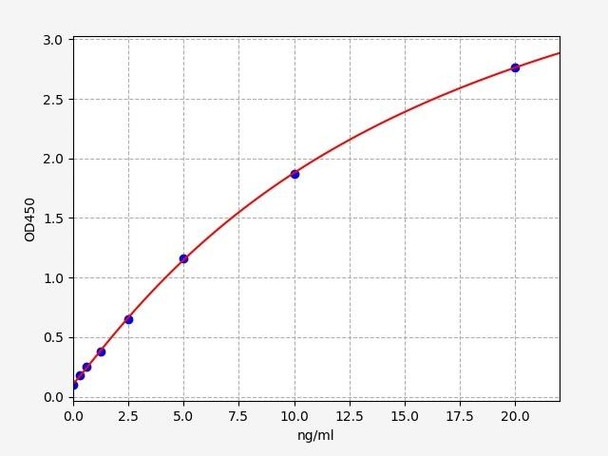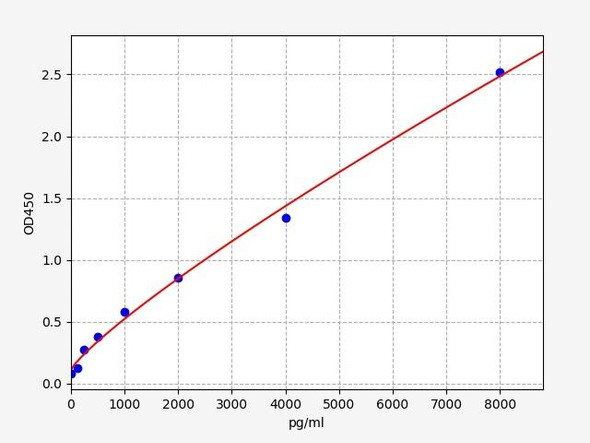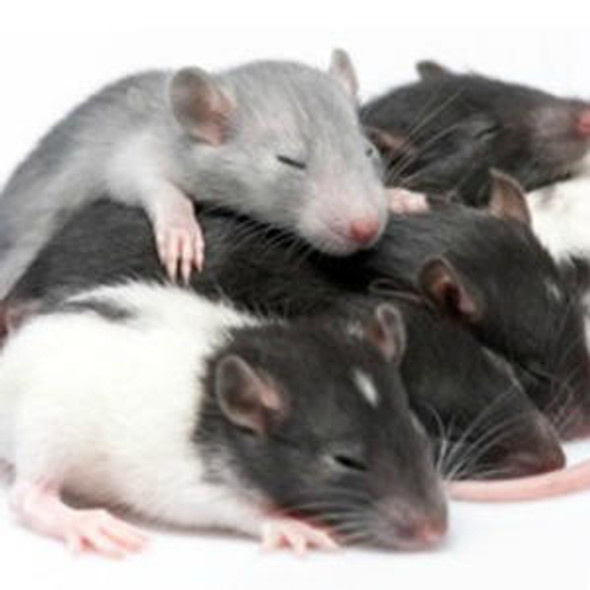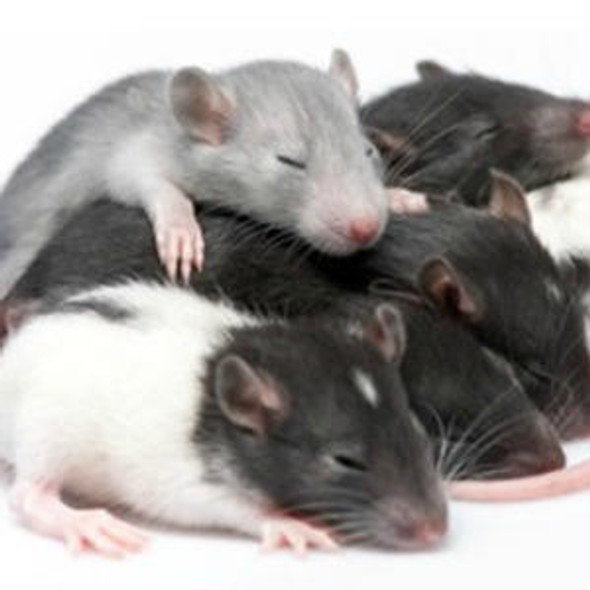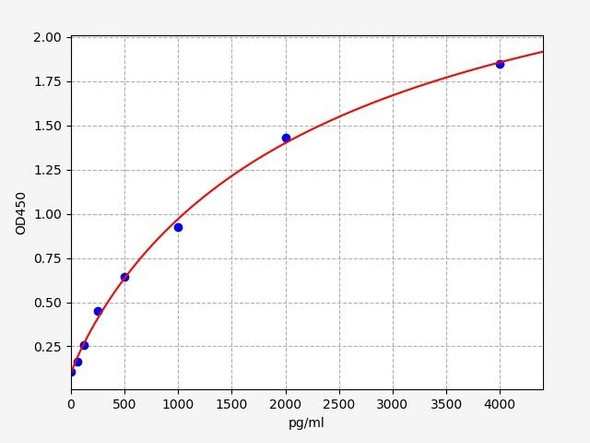Rat HSP-60 ELISA Kit
- SKU:
- RTFI00874
- Product Type:
- ELISA Kit
- Size:
- 96 Assays
- Uniprot:
- P63039
- Sensitivity:
- 0.188ng/ml
- Range:
- 0.313-20ng/ml
- ELISA Type:
- Sandwich ELISA, Double Antibody
- Synonyms:
- HSP-60, HSPD1, Heat Shock Protein 60, cpn60, GROEL, SPG13, 60 kDa chaperonin, Chaperonin 60, heat shock 60kD protein 1, chaperonin, Heat shock protein 60, heat shock protein 65, HLD4, Hsp60, HSP65, HuCHA60, P60 lymphocyte protein, short heat shock pr
- Reactivity:
- Rat
Description
| Product Name: | Rat HSP-60 (Heat Shock Protein 60) ELISA Kit |
| Product Code: | RTFI00874 |
| Size: | 96 Assays |
| Target: | Rat HSP-60 |
| Alias: | HSP-60, HSPD1, Heat Shock Protein 60, cpn60, GROEL, SPG13, 60 kDa chaperonin, Chaperonin 60, heat shock 60kD protein 1, chaperonin, Heat shock protein 60, heat shock protein 65, HLD4, Hsp60, HSP65, HuCHA60, P60 lymphocyte protein, short heat shock protein 60 Hsp60s1, spastic paraplegia 13, autosomal dominant |
| Reactivity: | Rat |
| Detection Method: | Sandwich ELISA, Double Antibody |
| Sensitivity: | 0.188ng/ml |
| Range: | 0.313-20ng/ml |
| Storage: | 4°C for 6 months |
| Note: | For Research Use Only |
| Recovery: | Matrices listed below were spiked with certain level of Rat HSP-60 and the recovery rates were calculated by comparing the measured value to the expected amount of Rat HSP-60 in samples. | ||||||||||||||||
| |||||||||||||||||
| Linearity: | The linearity of the kit was assayed by testing samples spiked with appropriate concentration of Rat HSP-60 and their serial dilutions. The results were demonstrated by the percentage of calculated concentration to the expected. | ||||||||||||||||
| |||||||||||||||||
| Intra-Assay: | CV <8% | ||||||||||||||||
| Inter-Assay: | CV <10% |
| Uniprot: | P63039 |
| UniProt Protein Function: | HSP60: Implicated in mitochondrial protein import and macromolecular assembly. May facilitate the correct folding of imported proteins. May also prevent misfolding and promote the refolding and proper assembly of unfolded polypeptides generated under stress conditions in the mitochondrial matrix. Interacts with HRAS. Interacts with HBV protein X and HTLV-1 protein p40tax. Belongs to the chaperonin (HSP60) family. |
| UniProt Protein Details: | Protein type:Chaperone; Mitochondrial Cellular Component: Golgi apparatus; extracellular space; protein complex; cell surface; rough endoplasmic reticulum; intracellular membrane-bound organelle; mitochondrion; early endosome; coated pit; cytosol; lipid raft; secretory granule; mitochondrial crista; membrane; mitochondrial matrix; mitochondrial inner membrane; cytoplasm; plasma membrane; lipopolysaccharide receptor complex; cyclin-dependent protein kinase activating kinase holoenzyme complex; myelin sheath Molecular Function:insulin binding; protein binding; protease binding; protein heterodimerization activity; lipopolysaccharide binding; p53 binding; chaperone binding; ubiquitin protein ligase binding; double-stranded RNA binding; protein complex binding; misfolded protein binding; ATP binding Biological Process: B cell proliferation; T cell activation; positive regulation of apoptosis; positive regulation of interleukin-12 production; isotype switching to IgG isotypes; response to lipopolysaccharide; response to organic cyclic substance; positive regulation of interleukin-10 production; response to organic substance; protein refolding; negative regulation of neuron apoptosis; positive regulation of T cell mediated immune response to tumor cell; positive regulation of interferon-alpha production; positive regulation of macrophage activation; caspase activation; response to drug; B cell activation; chaperone cofactor-dependent protein folding; protein stabilization; positive regulation of interleukin-6 production; B cell cytokine production; detection of misfolded protein; response to cocaine; response to unfolded protein; response to ATP; MyD88-dependent toll-like receptor signaling pathway; positive regulation of interferon-gamma production; 'de novo' protein folding; response to hydrogen peroxide; response to estrogen stimulus; response to heat; response to hypoxia; positive regulation of T cell activation; negative regulation of apoptosis; positive regulation of inflammatory response |
| NCBI Summary: | a stress-inducible molecular chaperone which participates in protein folding [RGD, Feb 2006] |
| UniProt Code: | P63039 |
| NCBI GenInfo Identifier: | 51702230 |
| NCBI Gene ID: | 63868 |
| NCBI Accession: | P63039.1 |
| UniProt Secondary Accession: | P63039,P19226, P19227, P97602, |
| UniProt Related Accession: | P63039 |
| Molecular Weight: | 60,955 Da |
| NCBI Full Name: | 60 kDa heat shock protein, mitochondrial |
| NCBI Synonym Full Names: | heat shock protein 1 (chaperonin) |
| NCBI Official Symbol: | Hspd1 |
| NCBI Official Synonym Symbols: | Hsp60; Hspd1-30p |
| NCBI Protein Information: | 60 kDa heat shock protein, mitochondrial; CPN60; HSP-60; HSP-65; chaperonin 60; 60 kDa chaperonin; heat shock 60kDa protein 1; heat shock protein 60 (liver); mitochondrial matrix protein P1; heat shock 60kD protein 1 (chaperonin) |
| UniProt Protein Name: | 60 kDa heat shock protein, mitochondrial |
| UniProt Synonym Protein Names: | 60 kDa chaperonin; Chaperonin 60; CPN60; HSP-65; Heat shock protein 60; HSP-60; Hsp60; Mitochondrial matrix protein P1 |
| Protein Family: | 60 kDa heat shock protein |
| UniProt Gene Name: | Hspd1 |
| UniProt Entry Name: | CH60_RAT |
| Step | Procedure |
| 1. | Set standard, test sample and control (zero) wells on the pre-coated plate respectively, and then, record their positions. It is recommended to measure each standard and sample in duplicate. Wash plate 2 times before adding standard, sample and control (zero) wells! |
| 2. | Aliquot 0.1ml standard solutions into the standard wells. |
| 3. | Add 0.1 ml of Sample / Standard dilution buffer into the control (zero) well. |
| 4. | Add 0.1 ml of properly diluted sample ( Human serum, plasma, tissue homogenates and other biological fluids.) into test sample wells. |
| 5. | Seal the plate with a cover and incubate at 37°C for 90 min. |
| 6. | Remove the cover and discard the plate content, clap the plate on the absorbent filter papers or other absorbent material. Do NOT let the wells completely dry at any time. Wash plate X2. |
| 7. | Add 0.1 ml of Biotin- detection antibody working solution into the above wells (standard, test sample & zero wells). Add the solution at the bottom of each well without touching the side wall. |
| 8. | Seal the plate with a cover and incubate at 37°C for 60 min. |
| 9. | Remove the cover, and wash plate 3 times with Wash buffer. Let wash buffer rest in wells for 1 min between each wash. |
| 10. | Add 0.1 ml of SABC working solution into each well, cover the plate and incubate at 37°C for 30 min. |
| 11. | Remove the cover and wash plate 5 times with Wash buffer, and each time let the wash buffer stay in the wells for 1-2 min. |
| 12. | Add 90 µL of TMB substrate into each well, cover the plate and incubate at 37°C in dark within 10-20 min. (Note: This incubation time is for reference use only, the optimal time should be determined by end user.) And the shades of blue can be seen in the first 3-4 wells (with most concentrated standard solutions), the other wells show no obvious color. |
| 13. | Add 50 µL of Stop solution into each well and mix thoroughly. The color changes into yellow immediately. |
| 14. | Read the O.D. absorbance at 450 nm in a microplate reader immediately after adding the stop solution. |
When carrying out an ELISA assay it is important to prepare your samples in order to achieve the best possible results. Below we have a list of procedures for the preparation of samples for different sample types.
| Sample Type | Protocol |
| Serum: | If using serum separator tubes, allow samples to clot for 30 minutes at room temperature. Centrifuge for 10 minutes at 1,000x g. Collect the serum fraction and assay promptly or aliquot and store the samples at -80°C. Avoid multiple freeze-thaw cycles. If serum separator tubes are not being used, allow samples to clotovernight at 2-8°C. Centrifuge for 10 minutes at 1,000x g. Removeserum and assay promptly or aliquot and store the samples at-80°C. Avoid multiple freeze-thaw cycles. |
| Plasma: | Collect plasma using EDTA or heparin as an anti-coagulant. Centrifuge samples at 4°C for 15 mins at 1000 — g within 30 mins of collection. Collect the plasma fraction and assay promptly or aliquot and store the samples at -80°C. Avoid multiple freeze-thaw cycles.Note: Over haemolysed samples are not suitable for use with this kit. |
| Urine & Cerebrospinal Fluid: | Collect the urine (mid-stream) in a sterile container, centrifuge for 20 mins at 2000-3000 rpm. Remove supernatant and assay immediately. If any precipitation is detected, repeat the centrifugation step. A similar protocol can be used for cerebrospinal fluid. |
| Cell Culture Supernatant: | Collect the cell culture media by pipette, followed by centrifugation at 4°C for 20 mins at 1500 rpm. Collect the clear supernatant and assay immediately. |
| Cell Lysates: | Solubilize cells in lysis buffer and allow to sit on ice for 30 minutes. Centrifuge tubes at 14,000 x g for 5 minutes to remove insoluble material. Aliquot the supernatant into a new tube and discard the remaining whole cell extract. Quantify total protein concentration using a total protein assay. Assay immediately or aliquot and store at ≤ -20°C. |
| Tissue Homogenates: | The preparation of tissue homogenates will vary depending upon tissue type. Rinse tissue with 1X PBS to remove excess blood & homogenizein 20ml of 1X PBS (including protease inhibitors) and store overnight at ≤ -20°C. Two freeze-thaw cycles are required to break the cell membranes. To further disrupt the cell membranes you can sonicate the samples. Centrifuge homogenates for 5 mins at 5000xg. Remove the supernatant and assay immediately or aliquot and store at -20°C or-80°C. |
| Tissue Lysates: | Rinse tissue with PBS, cut into 1-2 mm pieces, and homogenize with a tissue homogenizer in PBS. Add an equal volume of RIPA buffer containing protease inhibitors and lyse tissues at room temperature for 30 minutes with gentle agitation. Centrifuge to remove debris. Quantify total protein concentration using a total protein assay. Assay immediately or aliquot and store at ≤ -20 °C. |
| Breast Milk: | Collect milk samples and centrifuge at 10,000 x g for 60 min at 4°C. Aliquot the supernatant and assay. For long term use, store samples at -80°C. Minimize freeze/thaw cycles. |

